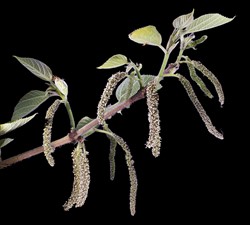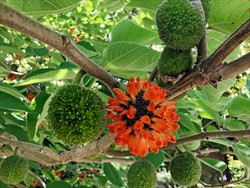- Worldwide distribution. In Australia, Cook Islands, French Polynesia, Fiji, New Caledonia, New Zealand, PNG, Samoa, Solomon Islands, Tonga, Wallis & Futuna.
- Highly invasive: thickets at edges of forests or in gaps within, abandoned farmlands, grasslands, roadsides, up to 1000 masl. Damaging environmental weed, outcompeting native species. Causes allergies.
- Trees to 20 m, with latex, greyish-brown grooved bark; leaves characteristically deeply 3 to 5-lobed in spirals along stems. Separate male and female trees. Male flowers in long clusters (catkins), female flowers thin, tubular in a spherical cluster, turning red as fruits mature.
- Spread: seeds dispersed by birds, bats, mammals, water. Long distance by human migrations, and lately international trade. Seed sold on Internet.
- Biosecurity: low risk; distribution wide; however, PRA in Queensland (already present) predicts areas where dense thickets could form replacing native vegetation.
- Biocontrol: none.
- Cultural control: hand-pulling; collect stem pieces and burn. Avoid using topsoil where paper mulberry grown previously.
- Chemical control: See full Fact Sheet no. 436 on African Tulip: (i) triclopyr + picloram; (ii) triclopyr + picloram + aminopyralid, or (iii) glyphosate, and treat either by cut stump/paint method or ring bark method (see Full Fact sheets for details).







